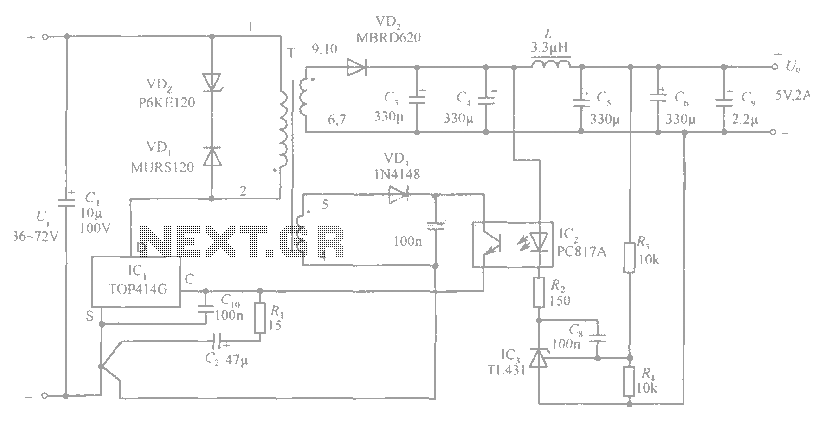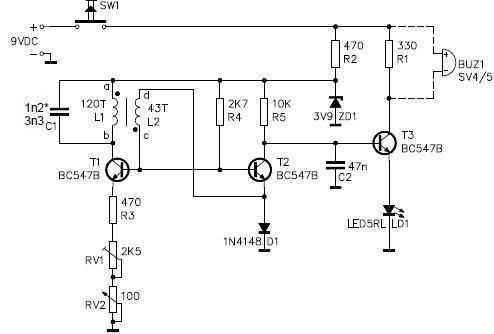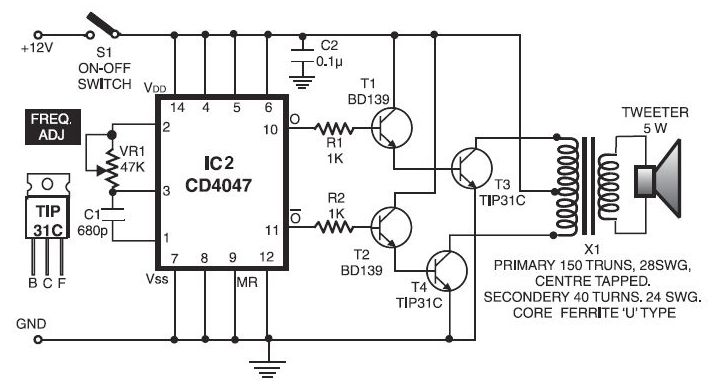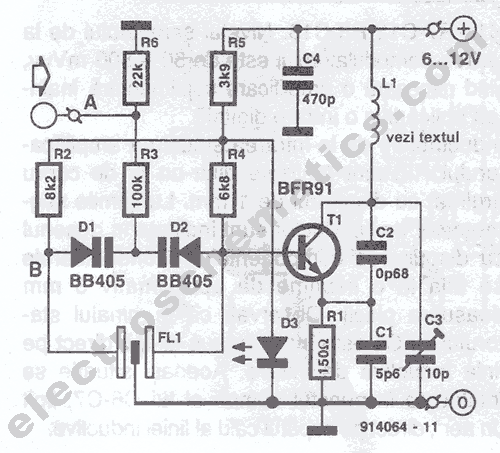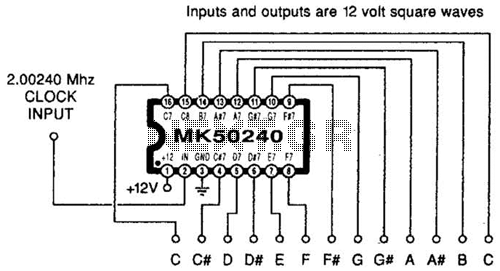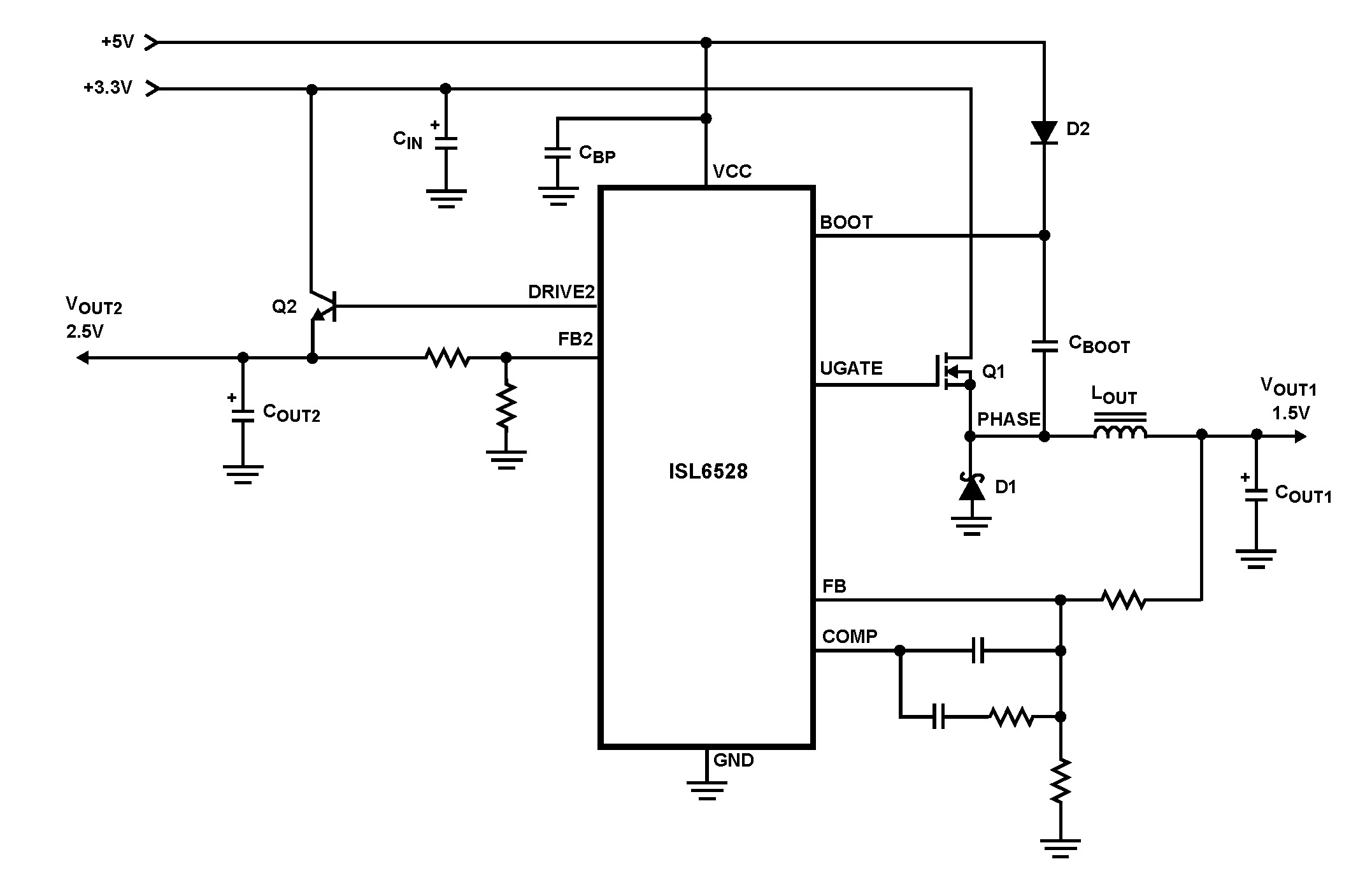
fan control circuit using ntc and tl082

R1 is a 15k ohm resistor. An NTC thermistor rated at 10k ohm, available at Radio Shack in the United States, is utilized. P1 is a 10k ohm potentiometer that sets the low speed (voltage) of the fans at cooler temperatures. P2 is a 50k ohm potentiometer that adjusts the gain of the circuit, determining how quickly the voltage rises to full output as the temperature increases. The TL082 is an op-amp that is available; most single voltage op-amps should be suitable. The TL082 is a dual op-amp, allowing for multiple controllers on a single board. It should be noted that the power and ground connections for the op-amp are not depicted in the schematic. R2 is included to reduce oscillation, as the TL082 is a fast op-amp. The IRF-510 is a 4 amp MOSFET in a TO-220 package. As the voltage on the gate increases, the MOSFET will conduct more current. There are also IRF-520 and IRF-530 versions that can handle higher current. It is important to note that even at 5 watts, the MOSFET will dissipate some heat and will require a heatsink or should be placed in an airflow path. The large metal part of the FET will be at the drain (D) voltage level; it should not be attached to the case. D1 can be any diode, with the 1N4001 being a suitable choice, as it conducts back around the fan when the MOSFET turns off. As the fan continues to spin, it generates a voltage on the drain lead of the FET, and D1 will limit that voltage. For adjustment, it is easiest to use a voltmeter, although it can be done without one. The thermistor should be at room temperature initially. P1 should be adjusted to set the desired low speed for the fans. The thermistor can be heated to the high temperature at which the fans should operate at full speed (placing it under the tongue works well). P2 should then be adjusted until the fans reach full speed (the highest voltage achievable); P2 should be fine-tuned until the speed/voltage begins to drop off. Most fan specifications indicate a low voltage limit of around 7 volts, while some smaller 80mm fans may have a lower limit of 8 volts. If the low voltage is set too low, the fans may stall until the thermistor reaches the necessary temperature.
The circuit described is an effective temperature-controlled fan speed regulator, utilizing a combination of resistors, potentiometers, an NTC thermistor, and a MOSFET to modulate fan speed based on temperature changes. The NTC thermistor provides a temperature-dependent resistance that decreases as the temperature increases, allowing for precise control over the fan's operation. The use of the TL082 op-amp facilitates signal amplification and processing, ensuring that the control signals are robust enough to drive the MOSFET effectively.
The IRF-510 MOSFET acts as a switch that regulates the power delivered to the fan. Its gate voltage controls the amount of current flowing through the device, with higher gate voltages resulting in greater current flow. This characteristic allows the circuit to respond dynamically to temperature changes, adjusting fan speeds accordingly. The inclusion of a diode (D1) serves to protect the circuit from back EMF generated by the fan’s inductive load when the MOSFET is turned off, ensuring circuit stability and longevity.
In practical implementation, careful calibration of the potentiometers (P1 and P2) is essential to achieve the desired fan performance. The circuit can be integrated into various applications where temperature regulation is crucial, such as in computer cooling systems, HVAC systems, or any environment where heat dissipation is necessary. The design considerations, including heat management for the MOSFET and proper component ratings, are critical for reliable operation. Overall, this schematic provides a comprehensive solution for automated fan speed control based on ambient temperature conditions.R1 15k ohm resistor. NTC Thermistor- 10k ohm, sold at Radio Shack in the states. P1 10k ohm potentiometer - sets the low speed(voltage) of the fans at the cool temperature. P2 50K ohm potentiometer - sets the gain of the circuit - how fast the voltage will rise to full output when the temp is higher. TL082 a op-amp that I had handy, most any singl e voltage op-amp should work. The TL082 is a dual op-amp if you want more then one controller on a board. note that the power and ground connections for the op-amp are not shown on the schematic. R2 - The TL082 is a fast op-amp, needed R2 to reduce oscillation. IRF-510 A 4 amp mos-fet in a TO-220 case. Bascially as the voltage on the gate rises the mos-fet will conduct more current. note 1 there are also IRF-520 and 530 versions that will handle more current. note 2 Even at 5 watts the mos-fet will disapate some heat and will need to be heat-sinked or at least in the air flow path. the large metal part of the fet will be at drain(D) voltage level. Do not attach to case. D1, almost any diode, 1N4001 should work, it conducts back around the fan when the mosfet turns off. As the fan continues spinning it will produce a voltage on the drain lead of the fet. D1 will limit that voltage. Adjustment, easiest if you have a voltmeter but can be done without. Get the thermistor at room temp. Adjust P1 for the low speed that you want your fans to run at. Heat the thermistor to the high temp you want the fans at full speed. ( I stuck it under my tongue) Adjust P2 until the fans are at full speed( with voltmeter the highest voltage you can get) then adjust P2 until the speed/voltage just begins to drop off.
Most fan specs that I have seen show a low voltage limit of around 7 volts. Some of the smaller 80mm fans have a lower limit of 8 volts. If you set the low voltage to low the fans may stall until the thermistor heats up enough. Let me know if you build this circuit and how it works for you. corrected, single voltage op-amps should be used, OP-07 is a dual voltage. 🔗 External reference
The circuit described is an effective temperature-controlled fan speed regulator, utilizing a combination of resistors, potentiometers, an NTC thermistor, and a MOSFET to modulate fan speed based on temperature changes. The NTC thermistor provides a temperature-dependent resistance that decreases as the temperature increases, allowing for precise control over the fan's operation. The use of the TL082 op-amp facilitates signal amplification and processing, ensuring that the control signals are robust enough to drive the MOSFET effectively.
The IRF-510 MOSFET acts as a switch that regulates the power delivered to the fan. Its gate voltage controls the amount of current flowing through the device, with higher gate voltages resulting in greater current flow. This characteristic allows the circuit to respond dynamically to temperature changes, adjusting fan speeds accordingly. The inclusion of a diode (D1) serves to protect the circuit from back EMF generated by the fan’s inductive load when the MOSFET is turned off, ensuring circuit stability and longevity.
In practical implementation, careful calibration of the potentiometers (P1 and P2) is essential to achieve the desired fan performance. The circuit can be integrated into various applications where temperature regulation is crucial, such as in computer cooling systems, HVAC systems, or any environment where heat dissipation is necessary. The design considerations, including heat management for the MOSFET and proper component ratings, are critical for reliable operation. Overall, this schematic provides a comprehensive solution for automated fan speed control based on ambient temperature conditions.R1 15k ohm resistor. NTC Thermistor- 10k ohm, sold at Radio Shack in the states. P1 10k ohm potentiometer - sets the low speed(voltage) of the fans at the cool temperature. P2 50K ohm potentiometer - sets the gain of the circuit - how fast the voltage will rise to full output when the temp is higher. TL082 a op-amp that I had handy, most any singl e voltage op-amp should work. The TL082 is a dual op-amp if you want more then one controller on a board. note that the power and ground connections for the op-amp are not shown on the schematic. R2 - The TL082 is a fast op-amp, needed R2 to reduce oscillation. IRF-510 A 4 amp mos-fet in a TO-220 case. Bascially as the voltage on the gate rises the mos-fet will conduct more current. note 1 there are also IRF-520 and 530 versions that will handle more current. note 2 Even at 5 watts the mos-fet will disapate some heat and will need to be heat-sinked or at least in the air flow path. the large metal part of the fet will be at drain(D) voltage level. Do not attach to case. D1, almost any diode, 1N4001 should work, it conducts back around the fan when the mosfet turns off. As the fan continues spinning it will produce a voltage on the drain lead of the fet. D1 will limit that voltage. Adjustment, easiest if you have a voltmeter but can be done without. Get the thermistor at room temp. Adjust P1 for the low speed that you want your fans to run at. Heat the thermistor to the high temp you want the fans at full speed. ( I stuck it under my tongue) Adjust P2 until the fans are at full speed( with voltmeter the highest voltage you can get) then adjust P2 until the speed/voltage just begins to drop off.
Most fan specs that I have seen show a low voltage limit of around 7 volts. Some of the smaller 80mm fans have a lower limit of 8 volts. If you set the low voltage to low the fans may stall until the thermistor heats up enough. Let me know if you build this circuit and how it works for you. corrected, single voltage op-amps should be used, OP-07 is a dual voltage. 🔗 External reference
